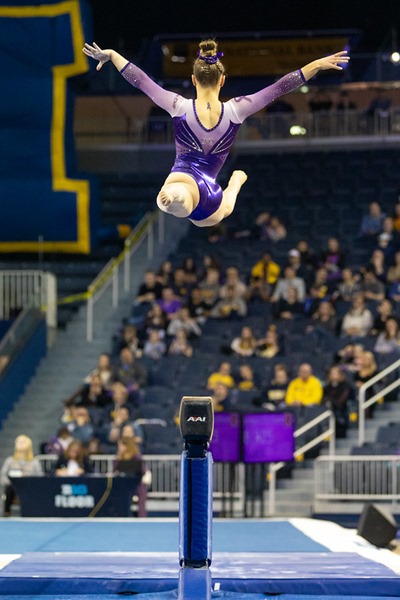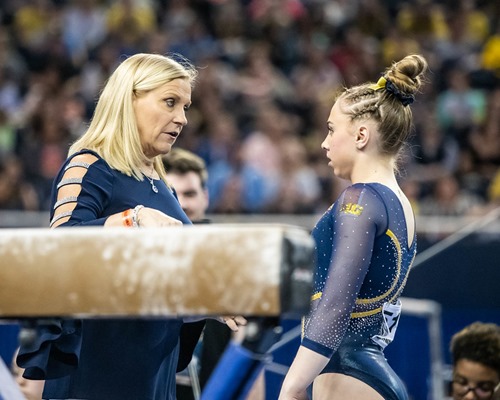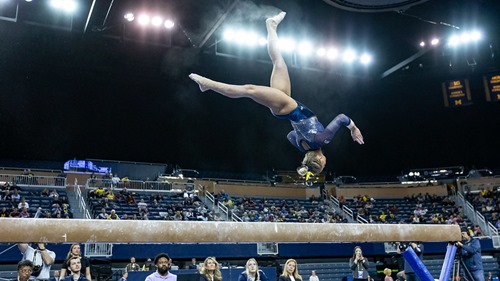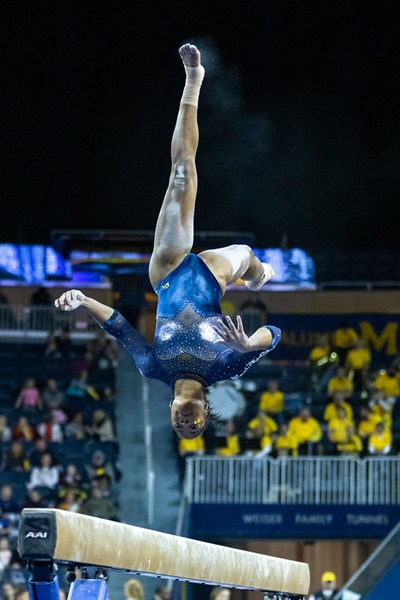
Steel

I want you to try something.
Extend your arm out until your elbow is straight, and hold your thumb and index finger about four inches apart. That’s a little wider than a credit card. A little less than half the width of a piece of notebook paper. Got it? Cool.
Now read this.

Now look back at your fingers.
Now imagine building up to his moment for fifteen years. The thousands of practice routines. The injuries. The gigantic bruises. The unimaginably large blisters (referred to quaintly as “rips,” but which, man, you do not want to Google Image Search that) that every bar worker suffers. The frustration of learning new skills, each of which seems physically impossible until it is mastered, at which time your reward is trying to add another half-twist. The pain and heartbreak of the uncountable falls that inevitably accompany a sport seemingly designed by someone unfamiliar with the normal mechanics of the human body.
Now imagine training for a year during COVID. Learning to practice with a mask on. Being isolated from your family. Getting tested six times a week in both nostrils until your nose bleeds. Staying away from normal college activities for fear that you could end your entire team’s season at any time by being in the wrong place at the wrong time. Enduring two weeks away from the gym mid-season in a sport built on consistency and repeatability. Surviving and advancing through NCAA Regional semifinals. And Regional finals. And National semifinals. And the first three rotations of National finals, on national television with a record audience watching.

JD Scott
The NCAA women’s gymnastics tournament consists of 1,632 routines. 1,631 were in the books.
One routine was left.
[Hit THE JUMP]
With the possible exceptions of Softball and Men’s Swimming and Diving, Women’s Gymnastics has been arguably the most successful athletic program at Michigan over the past three decades. Michigan has won 24 of the last 30 Big Ten championships. Head Coach Bev Plocki has more Big Ten titles than any coach, at any school, in any sport, ever. They’ve made 25 NCAA Championship appearances, 12 Super Sixes*, and one Four on the Floor* appearance during that time.
Fifty-two Michigan gymnasts have won a combined 199 All-American honors under Plocki, including 14 this year. Five Wolverines have won 9 individual NCAA champions, including All-Around titles by former Olympic Captain Elise Ray in 2001 and Kylee Botterman in 2011.

Dianna Oatridge
Plocki was National Coach of the Year in 1994, and has 11 Big Ten Coach of the Year and 11 Regional Coach of the Year awards to her name. Associate Head Coach Scott Sherman, who has been in Ann Arbor for 25 seasons, was the 2008 National Assistant Coach of the Year and has earned 7 Regional Coach of the Year honors. The rafters at the Donald R. Shepherd Gymnastic Training Center, not even 20 years old, are already running out of room.
They had won absolutely everything there was to win, and conquered all there was to conquer. Except this.
* The NCAA recently changed the format for the women’s gymnastics championships, which used to feature twelve teams in the championship semi-finals and six in the finals. Six teams on four events meant two bye rotations, which was both drawn out and clunky. The current format is inarguably better and more exciting. Also, “Four on the Floor” is a cooler name. Well done all around.
Gymnastics is a hard sport for a lot of us to understand.
That isn’t because it is particularly complicated. The rules of college gymnastics are pretty straightforward: a gymnast performs a routine. Different skills have different difficulties, and different errors when performing those skills have different deductions. Judges subtract those deductions from the value of the routine and post a score. High and low judges are thrown out, and the rest are averaged to give a score for that routine. Each team performs six routines on each event. The low score is dropped, the rest are totaled. 50 possible points on each event x 4 events = 200 possible points. High score wins.
No, it’s hard to understand because it is so far from anything that normal people can do, or have ever done. Most of us have shot a basketball or swung a baseball bat. A lot of us played high school sports. We’ve played pickup games and beer league softball. So even if we know we aren’t Steph Curry or Denard Robinson, we can understand what the players are doing. It is worlds apart from our experiences with those sports, but we recognize it. We can relate to it.
When it comes to gymnastics, most of us have never advanced beyond somersaults and cartwheels. We simply can’t comprehend what these athletes are doing. We can’t instinctively separate the good from the great, or the great from the other-worldly. Is a whip-double Arabian tumbling pass better than a three-and-a-half twist to a punch front? On vault, should we be more impressed by the Yurchenko one-and-a-half with a little hop on the landing or a slightly under-rotated front one-and-a-half? I’ve been watching competitive gymnastics for nearly 30 years, and often the best I can muster is “goddang that looked cool.”

JD Scott
But beam? We all understand beam, at least on some level. Because we have all tried – and failed – to walk across something narrow. At best, we look like Karl Wallenda trying to span some great chasm: arms outstretched, eyes glued downward, very carefully placing one foot in front of the other. The beam makes its mistakes clear to even casual viewers. Athletes wobble. They lose their balance. They fall. There is no hiding those errors.
The average adult female foot is approximately 3.5 inches wide. The balance beam is 4 inches wide. The margin for error is pretty easy to understand.
Even among gymnasts, the beam is different. And no one – no one – wants to end a close competition on beam.
In most years, what Michigan had done would have been enough already. They were sitting on a team score of 198.075, which would have been the third highest score in program history. It would have been a winning score in all but four NCAA finals since 1990.
They led after the first rotation with a 49.625 on floor after registering five scores of 9.9125 or better. They actually exceeded that on vault with a 49.650 that included two 9.975’s, one each from Abby Heiskell and Sierra Brooks. Then they posted another huge bar score with a 49.4875.
Those are massive scores. They are highlight-of-the-meet scores for your average Saturday in January. The kind of scores that put most opponents away well before the final rotation. But on this Saturday, all it bought them was a lead of 0.1375 over Oklahoma and 0.1625 over Utah. The two just kept coming. They were like elite marathoners a stride back of the leader; not winning, and not even closing ground, but far from losing. They kept pace, waiting for any sign of weakness. Any stumble. Any moment of doubt.
Waiting for Michigan to blink.
JD Scott
And halfway through the beam rotation, it looked like Michigan had blinked. Coming into the event, Michigan hadn’t count anything lower than a 9.8625. But after Carly Bauman led off with a 9.85, Gabby Wilson posted a 9.75. An arm wave on her flight series. A little balance check on her quarter-turn leap. Lauren Farley followed it up with a 9.7625. A little wobble on an aerial. A little off on the dismount. That was it. Two perfectly fine routines with a perfectly decent score at a time when “fine” and “decent” were not enough.
The math wasn’t complicated, though the task was overwhelming. Michigan needed to nail its last three beam routines. Not hit them. Nail them. They had to be as close to perfect as the strictures of gymnastics allow. Sixty seconds on the beam. No mistakes. Three times. Four inches.
Women’s gymnastics is a sport of haves and have-nots. In the 38 seasons since the NCAA started handing out hardware, only 6 teams had ever hoisted the trophy. Georgia had done it ten times. Utah, nine. UCLA, seven. Alabama, six. Oklahoma, four. Florida, three. The rest of the college gymnastics world combined: zero.
Michigan had been close before. They finished second in 1995, losing to Utah by 0.225 points. They finished second in 1999, losing to Georgia by 0.300 points. They finished third in 2001, losing to UCLA by 0.300 points. But while they have continued their dominance of the Big Ten over the last decade, they had slipped, ever so slightly, in the national picture. Despite reaching Nationals almost every season since 1995, Michigan hadn’t reached the finals since 2011, and they had missed Nationals altogether in 2016 and 2018.
But as this season progressed, it hinted at the possibility of something special. Other than an ankle injury to junior Abby Brenner in February, Michigan stayed relatively healthy. They stayed COVID-free. And they started posting huge scores. They set a program record on March 7 with a score of 198.025, a mark that lasted all of five days until they broke it again with a 198.100 the following week. They won the NCAA Regional semifinal. They won the NCAA Regional final with another 198.100. And they won the NCAA Championship semi-final for the first time ever, leading wire-to-wire with the best score they had ever posted in any NCAA championship competition.
It started to seem possible.
The Code of Points is the scoring system for college gymnastics. It tells judges what to look for and how much to deduct for errors. You take a hop on a landing? That’s a one-tenth deduction. Touch your hand to the beam to keep from falling? Three-tenths. Fall off? That’s half a point.
By the time Sierra Brooks mounted the beam for Michigan’s fourth routine, Michigan was already guaranteed to count 0.3875 worth of deductions. They could absorb, perhaps, two more tenths between their final three routines. Maybe three tenths if Oklahoma stumbled a bit, though that seemed unlikely. To call Michigan an underdog at that moment would be generous.
But then Sierra Brooks did this:
And Natalie Wojcik, the reigning NCAA beam champion, did this:
A 9.9625 and a 9.9875. I’ve watched those routines over and over, and I still can’t spot the deductions. But in my defense, at least some of the judges agreed with me, with two of the six giving Brooks a perfect 10.0 and four judges doing the same for Wojcik.
Abby Heiskell had no way to know this, but when she began her routine, Michigan trailed Oklahoma by .0875. It was the first time Michigan had trailed all day. It was the first time Michigan had trailed since the second rotation of the Regional semifinal. After being a frontrunner for two weeks, Michigan couldn’t hold on. They had to take it back. But it was there to be taken.
And then… this.
Most Michigan fans probably won’t remember these three routines the way they remember Trey Burke’s shot against Kansas or Charles Woodson’s Ohio State heroics or the Mike Legg goal. At least not with the same specificity. Such is the fate of non-revenue sports. These athletes spend decades building to a moment, and we merely join them there, curious outsiders to the impossibly complicated and challenging world they inhabit.
We stay for a few weeks, or a few days, or even a few hours. We cheer. We emotionally invest ourselves. We learn, mid-stream, the nuances and the rules and the personalities and the backstories. And when it is over, we put those specifics away. We blend them together, and place them in a jar on the shelf carrying a generic label like “2019 Michigan Baseball” or “2015 Michigan Softball.” We occasionally open the lid and recall the feelings, but we forget many of the specifics.
Don’t let that happen here. Don’t allow yourself to forget the absolute steel in the spines of these three women to accomplish these three very specific tasks. All three had fantastic meets, posting career high all-around scores of 39.725 or better. And they were far from the only key contributors, either on Saturday or during the tournament run. Indeed, Michigan needed literally every tenth of every point from every routine. One more bobble, one step out of bounds, one short handstand, one hop on a landing, and Michigan leaves with a painful what-if.
But you can follow gymnastics for the rest of your life and not see anything more impressive than what Sierra Brooks, Natalie Wojcik, and Abby Heiskell did over that eight minute stretch. It should live in the annals of Michigan sports lore long after the confetti is swept up and the trophy finds a home on the shelf.
And the next time you feel like you are bearing the weight of the world on your shoulders, be grateful that you don’t have to do so on anything that narrow.
We were all watching at my house, part of that record viewership.
Happy to see a return to actual sports writing on the front page too. Great post. I do appreciate the informative posts on mgoblog but aside from those - the passion and quality of the editorials hasn't been what it once was, until this.
You NAILED it..I was on the edge of me seat the entire night start to finish I had to cover my eyes on the last 3 beam routines and only open them when the announcers excitedly talked about the dismount...what a all around PERFECT night...Michigan athletics has excelled during the most difficult year EVER and given us moments like this to let us forget for just a few hours few days or few weeks..Thanks to All of Michigan teams for a EXCELLENT year with more still to come.....
PS..BRILLIANT Post one of the best ive read on here You nailed the night PERFECTLY
Best MGO post ever?
Yes... Yes it is.
Incredible writing.
Finely written piece, celebrating an even finer performance by superb athletes.
An achievement to treasure.
I'm a gymnastics dad. My daughter was an elite club gymnast and then she did gymnastics in college and was the captain of her team for two years. I know the sport and understand the nuances and intricacies probably as well as any gymnastics dad ever could.
This is the best explanation of the sport that I've ever read.
There have been a lot of stories this week on Michigan winning the national championship, but all of them have been superficial at best. Nothing close to this.
The gymnasts on this team deserved a story like this. Bravo. And Go Blue.
An amazing column.....drama-filled excellent writing! Thanks (and thanks to the team) so much for this!!
Thank you for putting that amazing performance into perspective. A better tribute could not be written.
FANTASTIC write up. Worthy of the fantastic performance Michigan Women's Gymnastics gave to win their first National Championship!
BISB, I don't know what the org chart of MGoBlog looks like, I don't know if you are part of the staff or somebody who contributes stuff off to the side, I don't know if you get paid or not.
But you should know that your contributions are noticed, appreciated, and admired by all of us.
Wow, today had been a lousy day all around. What an awesome pick me up to read that. Thank you!
Fantastic!
So happy freakin' happy for coach Bev for getting this championship.
Now that you have one how about one more.
"And the next time you feel like you are bearing the weight of the world on your shoulders, be grateful that you don’t have to do so on anything that narrow."
Goosebumps. Well done sir!
April 22nd, 2021 at 11:12 PM ^
Fantastic! What great, clutch performances!
April 23rd, 2021 at 12:39 AM ^
That’s my new favorite version of *it’s great, to be, a Michigan Wolverine”, and it’s not even close.
This story read like it was straight out of Esquire. Thank you for sharing this with us.
...and yes, it’s great, to be, a Michigan Wolverine.
Go blue.
April 23rd, 2021 at 12:57 AM ^
I am such a sap. I watched every minute. I giggled and teared up a bit. I grew up a wrestler and football player with three athletic daughters and that video was just awesome. Bravo to those gals.
I wrote for The Daily in 91 and covered Bev in those early years. She was fantastic out of the gate and it was clear bog things were ahead. So happy for her and women who built this terrific program. Amazing stuff, this. Great to be a Michigan Wolverine.
April 23rd, 2021 at 10:01 AM ^
Didn't even watch this competition and this article got the waterworks going. Amazing accomplishment for these ladies!
April 23rd, 2021 at 10:14 AM ^
just in from the judges...this article scores a 10.00
(after dropping the 5.25 from the OSU judge)
best article ever written on MGOBlog!
thank you!!
April 23rd, 2021 at 12:07 PM ^
I haven't logged in for years and I had to do it to let you know how great this is.
Amazing
April 24th, 2021 at 10:36 AM ^
I really enjoyed reading this. I was going to tag you on a Twitter post I made, linking the article, but I don't know your handle!
April 25th, 2021 at 12:56 PM ^
Beautifully written! ??
Incredible post. I'm upset to have been as ignorant as I have about this sport, because holy shit the tension. I can't wait to pay more attention to it going forward

Comments